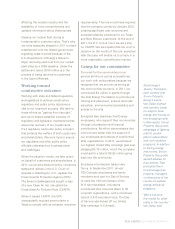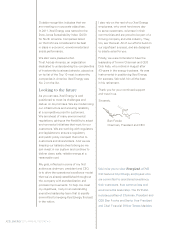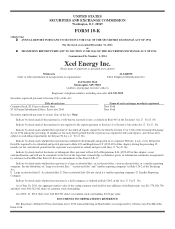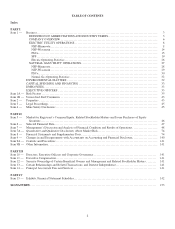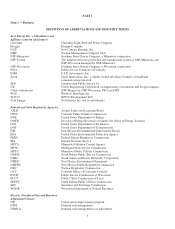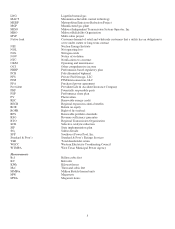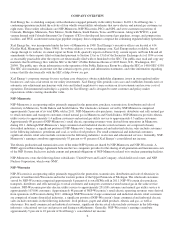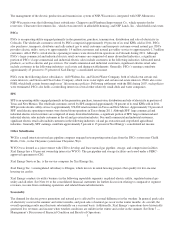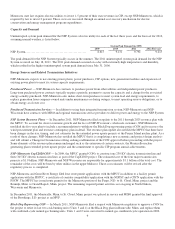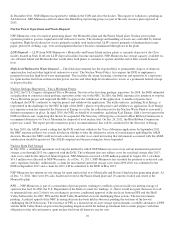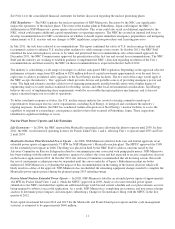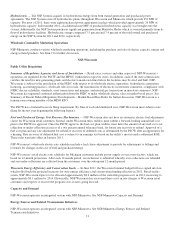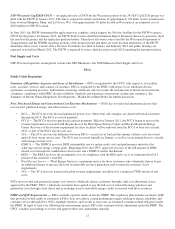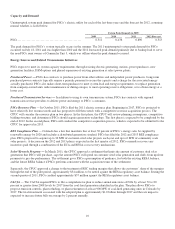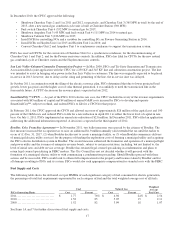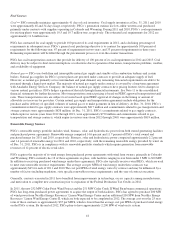Xcel Energy 2011 Annual Report Download - page 18
Download and view the complete annual report
Please find page 18 of the 2011 Xcel Energy annual report below. You can navigate through the pages in the report by either clicking on the pages listed below, or by using the keyword search tool below to find specific information within the annual report.8
Competition
Xcel Energy’s industrial and large commercial customers have the ability to own or operate facilities to generate their own
electricity. In addition, customers may have the option of substituting other fuels, such as natural gas, steam or chilled water for
heating, cooling and manufacturing purposes, or the option of relocating their facilities to a lower cost region. The FERC has
continued to promote competitive wholesale markets through open access transmission and other means. As a result, Xcel Energy
Inc.’s utility subsidiaries and their wholesale customers can purchase the output from generation resources of competing
wholesale suppliers and use the transmission systems of the utility subsidiaries on a comparable basis to serve their native load.
Xcel Energy Inc.’s utility subsidiaries also have franchise agreements with certain cities subject to periodic renewal. If a city
elected not to renew the franchise agreement, it could seek alternative means, such as municipalization. While each of Xcel
Energy Inc.’s utility subsidiaries faces these challenges, their rates are competitive with currently available alternatives.
ELECTRIC UTILITY OPERATIONS
NSP-Minnesota
Public Utility Regulation
Summary of Regulatory Agencies and Areas of Jurisdiction — Retail rates, services and other aspects of NSP-Minnesota’s
operations are regulated by the MPUC, the NDPSC and the SDPUC within their respective states. The MPUC also has regulatory
authority over security issuances, property transfers, mergers, dispositions of assets and transactions between NSP-Minnesota and
its affiliates. In addition, the MPUC reviews and approves NSP-Minnesota’s electric resource plans for meeting customers’ future
energy needs. The MPUC also certifies the need for generating plants greater than 50 MW and transmission lines greater than 100
KV that will be located within the state. No large power plant or transmission line may be constructed in Minnesota except on a
site or route designated by the MPUC. The NDPSC and SDPUC have regulatory authority over generation and transmission
facilities, along with the siting and routing of new generation and transmission facilities in North Dakota and South Dakota,
respectively.
NSP-Minnesota is subject to the jurisdiction of the FERC with respect to its wholesale electric operations, hydroelectric licensing,
accounting practices, wholesale sales for resale, transmission of electricity in interstate commerce, compliance with NERC
electric reliability standards, asset transfers and mergers, and natural gas transactions in interstate commerce. NSP-Minnesota has
requested continued authorization from the FERC to make wholesale electric sales at market-based prices. See Summary of
Recent Federal Regulatory Developments - Market-Based Rate Rules for further discussion. NSP-Minnesota is a transmission
owning member of the MISO RTO.
Fuel, Purchased Energy and Conservation Cost-Recovery Mechanisms — NSP-Minnesota has several retail adjustment clauses
that recover fuel, purchased energy and other resource costs:
• CIP — The CIP recovers the costs of programs that help customers save energy. CIP includes a comprehensive list of
programs that benefit all customers including Saver’s Switch®, energy efficiency rebates and energy audits.
• EIR — The EIR recovers the costs of environmental improvements to the A.S. King, High Bridge and Riverside plants,
which were renovated under the MERP program.
• GAP — The GAP is a surcharge billed to all non-interruptible customers to recover the costs of offering a low-income
customer co-pay program designed to reduce natural gas service disconnections.
• RDF — The RDF allocates money collected from retail customers to support the research and development of emerging
renewable energy projects and technologies.
• RES — The RES is a rider that recovers the costs of new renewable generation.
• SEP — The SEP recovers costs related to various energy policies approved by the Minnesota legislature.
• TCR — The TCR recovers costs associated with new investments in electric transmission.
NSP-Minnesota has requested that the recovery of the costs associated with the EIR and RES be included in base rates, which is
included in the Minnesota electric rate case currently pending approval with the MPUC.
NSP-Minnesota’s retail electric rates in Minnesota, North Dakota and South Dakota include a FCA for monthly billing
adjustments for changes in prudently incurred cost of fuel, fuel related items and purchased energy. NSP-Minnesota is permitted
to recover these costs through FCA mechanisms approved by the regulators in each jurisdiction. The FCA allows NSP-Minnesota
to bill customers for the cost of fuel and related costs used to generate electricity at its plants and energy purchased from other
suppliers. In general, capacity costs are not recovered through the FCA. In addition, costs associated with MISO are generally
recovered through either the FCA or through rate cases.



